LEO
11.2024


Recognition
Outstanding Project
Creative Interactions and Solutions | Monash University
Finalist
Victorian Premier's Design Awards
Shortlisted
Global Creative Graduate Showcase 2025 | Arts Thread
You can check out the full project portfolio here.
Understanding the Aging Technology Gap
Smart home technology promises convenience, efficiency, and independence, yet older adults remain the demographic least likely to adopt these systems. The problem isn't a lack of interest; the barrier is interaction design. Most smart home interfaces assume smartphone fluency, rely on abstract app-based controls, and require technical troubleshooting that feels inaccessible to people who didn't grow up with digital technology.
LEO emerged from in-home research with elderly users, exploring how they currently interact with home technology and where friction points exist. I spent time observing daily routines, asking about frustrations, and understanding what "intuitive" means to someone whose formative technology experiences were analog dials, physical switches, and mechanical controls. The central insight: older adults don't need simpler technology; they need technology that matches their existing mental models.


LEO on table
Defining Design Principles Through Research
The research phase revealed patterns that fundamentally shaped LEO's design direction. First, older adults strongly prefer physical controls over touchscreens or voice commands. Physical objects provide tactile feedback, spatial memory, and don't require remembering specific phrases or navigating nested menus. A thermostat dial feels intuitive because it maps directly to temperature: turn right for warmer, left for cooler. This one-to-one correspondence between action and outcome creates confidence.
Second, visual clarity matters enormously. Small text, low contrast interfaces, and abstract iconography create barriers. Older adults aren't necessarily visually impaired, but they benefit from generous sizing, high contrast, and literal representations over symbolic ones. A button showing a phone handset communicates more clearly than an abstract "call" icon.
Third, smart home value propositions often miss what older adults actually care about. Often convenience and automation are emphasised, but through my research I found that older adults wanted technology that gave them agency over their environment, not systems that made autonomous decisions. Automation felt like a loss of control rather than convenience.
These insights crystallised into core design principles: favour physical interactions over a touch screen, create direct mappings between control and outcome, prioritise clarity over minimalism, and design for user agency.


LEO in room
Developing the Modular System Concept
Rather than designing a unified control hub, I developed LEO as a modular system where each module handles a specific home function through dedicated physical controls. This approach emerged from observing that older adults organise their homes by function and location: the thermostat lives near the hallway, the phone sits on the side table, the speaker occupies the living room. A single control hub consolidates these functions in ways that disrupt established spatial patterns and mental models.
The module concept allows users to place controls where they make contextual sense. The thermostat module lives in the main living area where temperature is most relevant. The phone module sits where the user habitually makes calls. This distributed approach respects existing home organization while introducing smart capabilities.
Each module needed distinct form language while maintaining family cohesion. I drew inspiration from mid-century home electronics, particularly vintage radios and rotary phones, which older adults remember fondly and understand intuitively. Rounded forms, prominent controls, and warm materials created aesthetic continuity across modules while each module's specific function remained visually apparent.


Series of LEO modules
Form Development and Ergonomic Refinement
The formal development process balanced aesthetic appeal with ergonomic necessity. Older adults often experience reduced grip strength, joint stiffness, and decreased fine motor control. Controls needed to be large enough to operate comfortably, positioned to avoid awkward wrist angles, and require minimal force to activate.
I explored numerous form directions through sketching, considering how different geometries would sit in the hand, rest on surfaces, and communicate their function. Early concepts skewed too futuristic, which user testing revealed felt intimidating rather than inviting. I pivoted toward warmer, more familiar geometries that suggested craft and permanence rather than cutting-edge technology.
The thermostat module went through the most extensive iteration. The core interaction is a rotating dial, but the dial's size, resistance, and detent spacing all affect usability. Too small and it's difficult to grip; too large and it dominates the form. Too loose and it feels imprecise; too tight and it requires excessive force. I built multiple prototypes with varying dial characteristics, testing each with older adult users to find the optimal balance.
Button design required similar refinement. Early prototypes used more flush buttons that looked clean but provided minimal tactile feedback. Testing showed older users often weren't sure if they'd successfully pressed a button. I redesigned with proud buttons that travel visibly when pressed and provide clear tactile click feedback. This solved the uncertainty problem while making the modules feel more substantial and well-crafted.
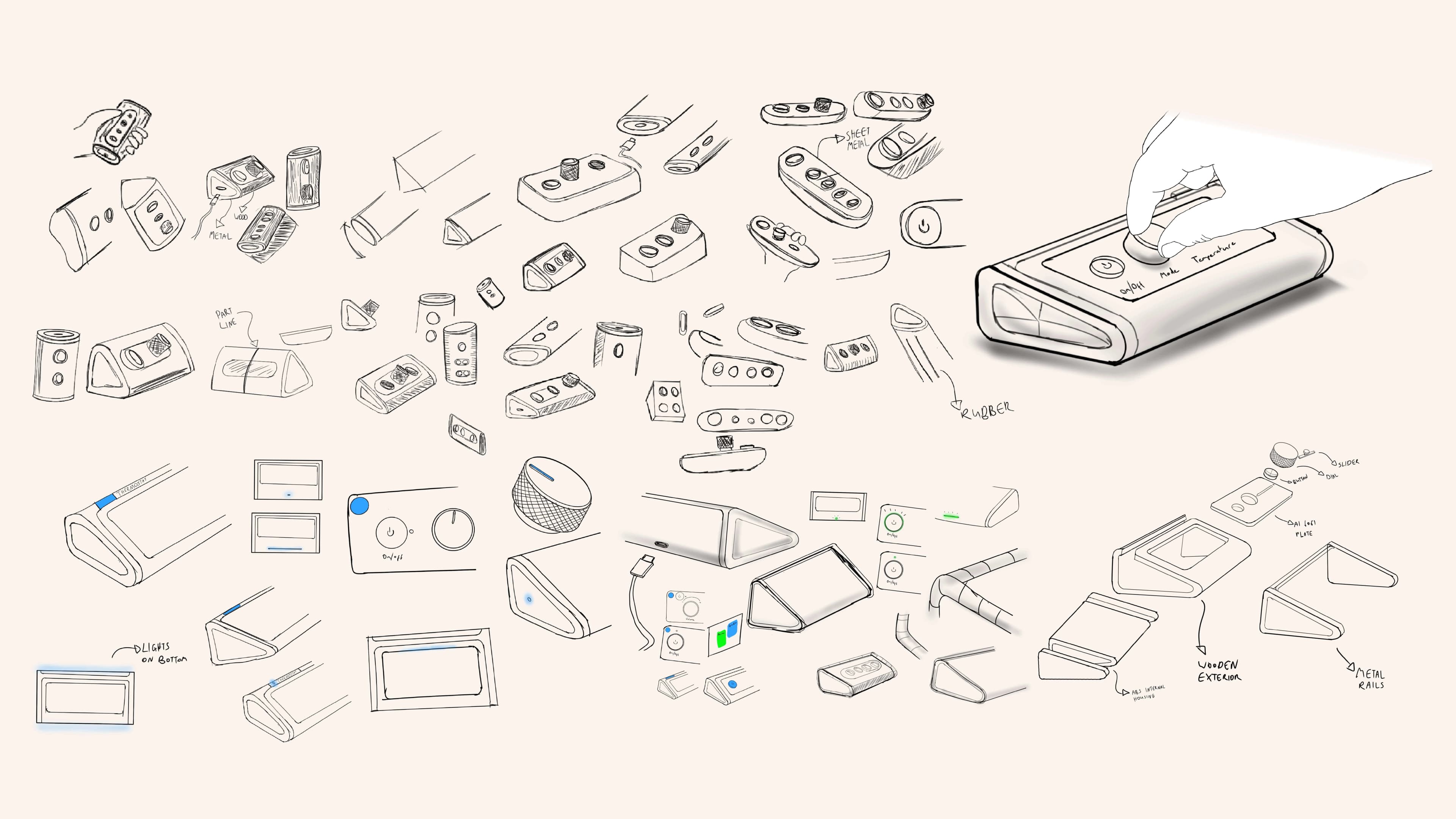

Sketch ideation
Prototyping Electronics Integration
Moving from aesthetic models to functional prototypes revealed integration challenges. The module, which I refined into a final prototype, needed microcontroller capability, lights, potentiometers and a tactile switch. Fitting these electronics into the refined form without compromising ergonomics or aesthetics required careful internal architecture planning.
I designed the internal layout to separate user-facing components from electronics. The dial mechanism mounts to the front housing with the rotary encoder behind it. The microcontroller (an Arduino Nano) sits vertically in the centre of the module. This organisation allowed for compact overall dimensions while maintaining clear assembly logic.
I programmed basic feedback responses: LED indicators confirming on and off states, as well as input feedback, button presses and potentiometer logic. This data was then connected to ProtoPie to provide display updates that reflect changed states. These feedback systems transformed static models into devices that felt responsive and alive, critical for user testing validation.
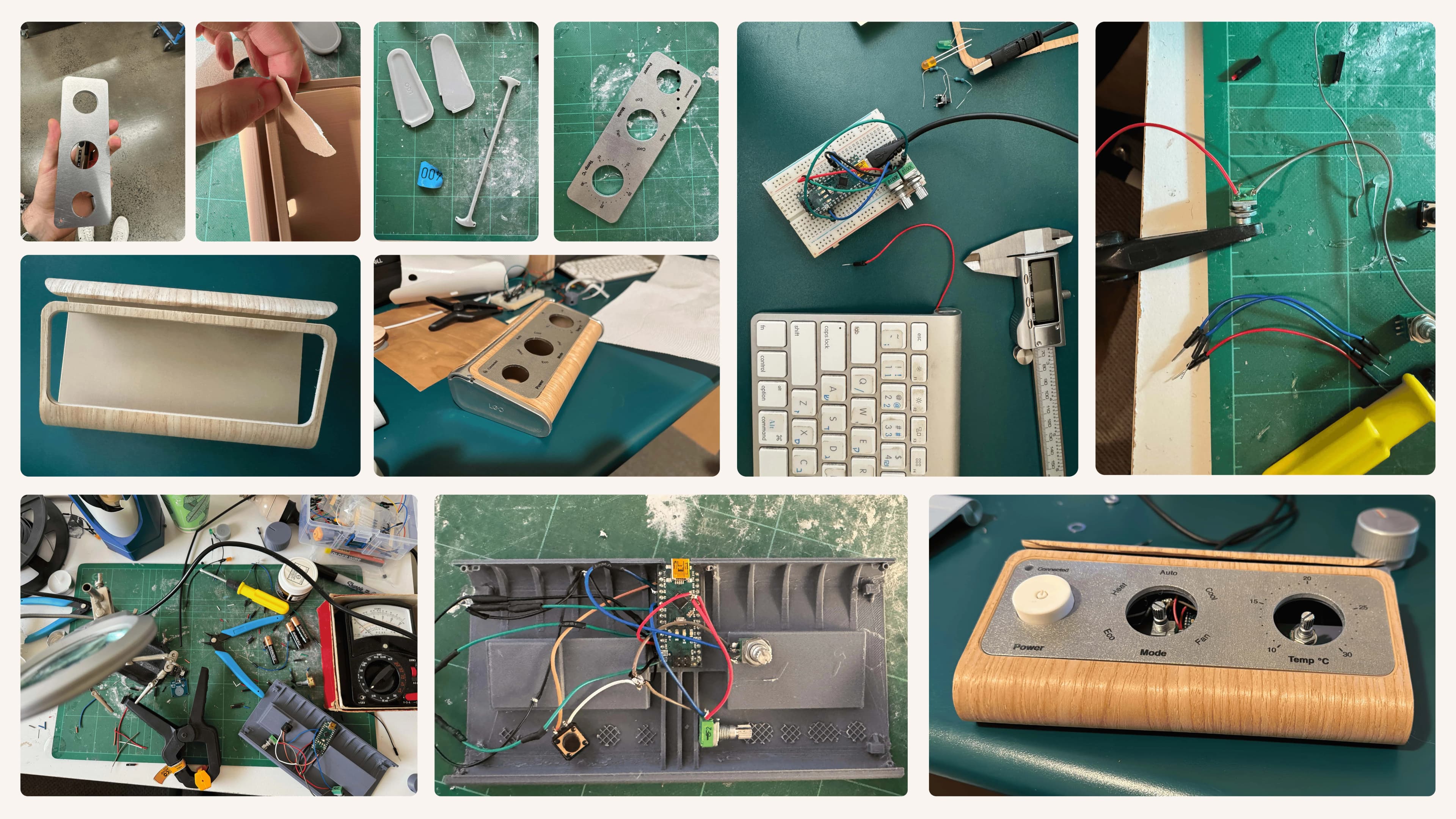

Prototype
Designing the Dashboard Experience
The LEO Home Center dashboard serves as the system's visual hub, displaying current home status and recent module interactions. The design challenge was creating an interface readable from across a room (older adults often have the dashboard visible from their chair or bed) while providing sufficient detail to be useful.
I structured information hierarchically with the most critical data, largest and most prominent: current temperature, time, and system status. Secondary information, like weather forecasts and recent notifications, occupies smaller zones. Colour coding helps quick interpretation with each colour associated with a colour-coded module.
Typography selection prioritised legibility. I chose a geometric sans-serif with tall x-height and generous letter spacing, sized substantially larger than typical dashboard interfaces. This created layouts that felt more spacious and less information-dense than conventional smart home displays, but testing confirmed older users could read and interpret information accurately from typical viewing distances.
The dashboard updates in real-time as users interact with modules, creating visible feedback loops that reinforce the connection between physical controls and system state. When a user adjusts the thermostat module, they see the dashboard temperature display update immediately. This cause-and-effect clarity builds confidence in the system.


Module with LEO Home Center
LEO Home Center
LEO at MADA NOW Exhibition
The Setup Service Strategy
Technology adoption failure often happens at setup. Complex installation processes, unclear instructions, and troubleshooting requirements create barriers that prevent older adults from ever getting systems operational. LEO addresses this through a guided setup service where a technician visits the user's home, demonstrates the system, customises module placement, and ensures everything works correctly before leaving.
This service model emerged to make the integration and adoption process as accessible as possible for older adults. The setup visit isn't just a technical installation; it's an educational session where the technician explains each module's function, demonstrates typical interactions, answers questions, and addresses concerns. This human touchpoint builds confidence and provides a support contact if issues arise later.
The setup process also allows for customisation based on the user's specific home and needs. The technician assesses which rooms need which modules, determines optimal placement locations, configures the dashboard in an ideal viewing position, and connects the system to the user's existing WiFi network. This personalised installation ensures LEO integrates smoothly into each unique home environment.
From a business perspective, the setup service creates an ongoing relationship between LEO and users. The initial setup visit establishes trust and demonstrates value. Follow-up support, module additions, and system updates all benefit from this established relationship. The service model also provides valuable usage data and user feedback that can inform product iteration.
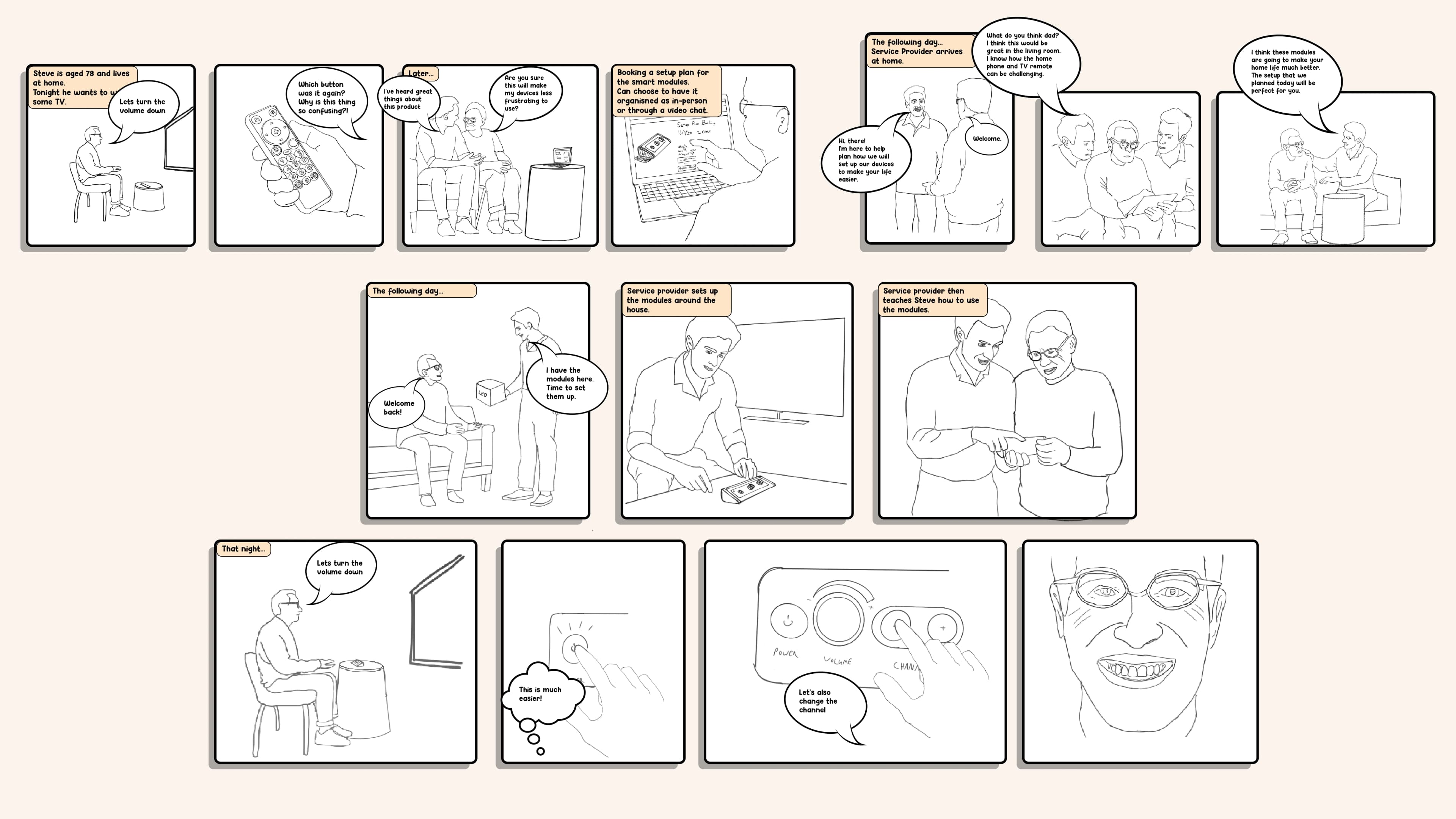

LEO setup service
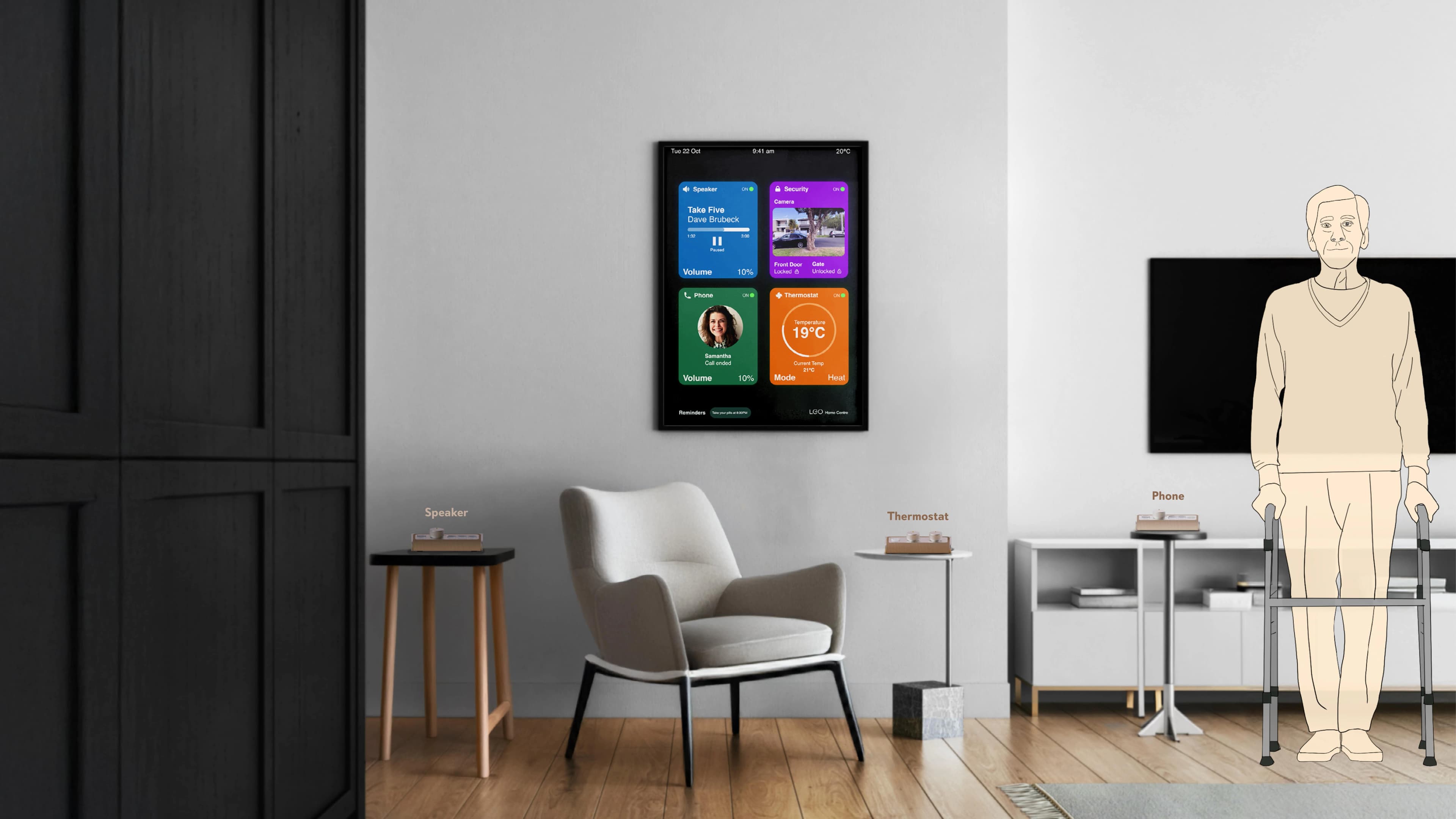

LEO system home layout
CAD Refinement and Visualisation
Once the form language and electronics integration were validated through prototypes, I moved to high-resolution CAD modelling in Fusion 360. This phase focused on manufacturing considerations: draft angles for moulding, wall thickness for structural integrity, assembly methods that could scale to production, and surface finishes that would feel premium.
I designed the housing as two-part assemblies that snap together with integrated clips, eliminating visible fasteners on exterior surfaces. Internal bosses provide mounting points for electronics without requiring separate hardware. Cable routing channels ensure wires remain organised and don't interfere with mechanical components. These details don't affect immediate functionality but determine whether a product feels thoughtfully engineered or hastily assembled.
KeyShot rendering allowed me to explore material and finish options without physical prototyping. I tested various combinations of matte and gloss surfaces, wood grain accents, and metal trims to find the aesthetic that best communicated warmth and quality. The final specification uses soft-touch matte plastic for primary surfaces (pleasant to touch, doesn't show fingerprints), with subtly glossy control surfaces (visual differentiation, easier to clean) and walnut wood accents (warmth, familiarity, premium positioning).
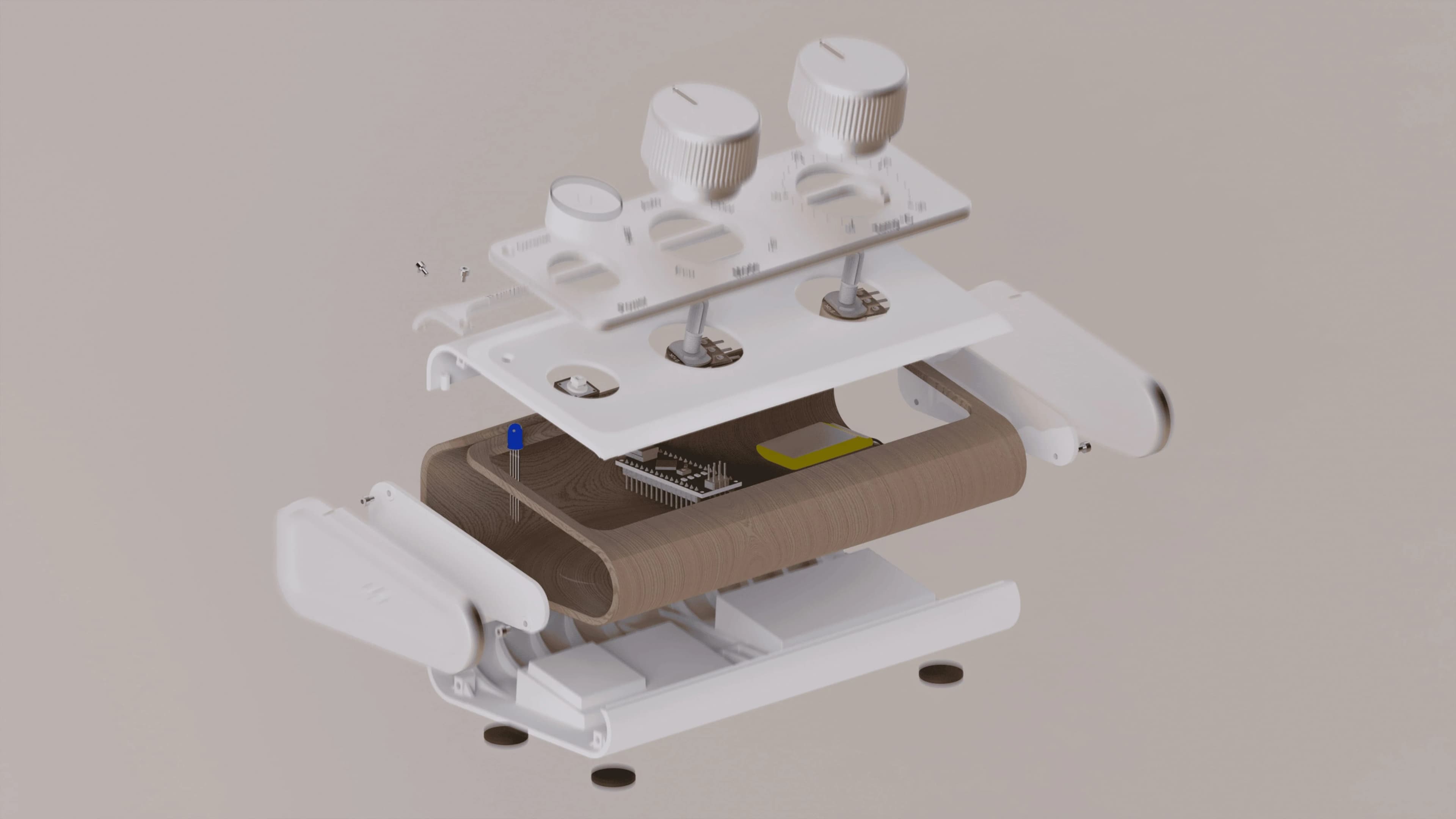

Exploded view
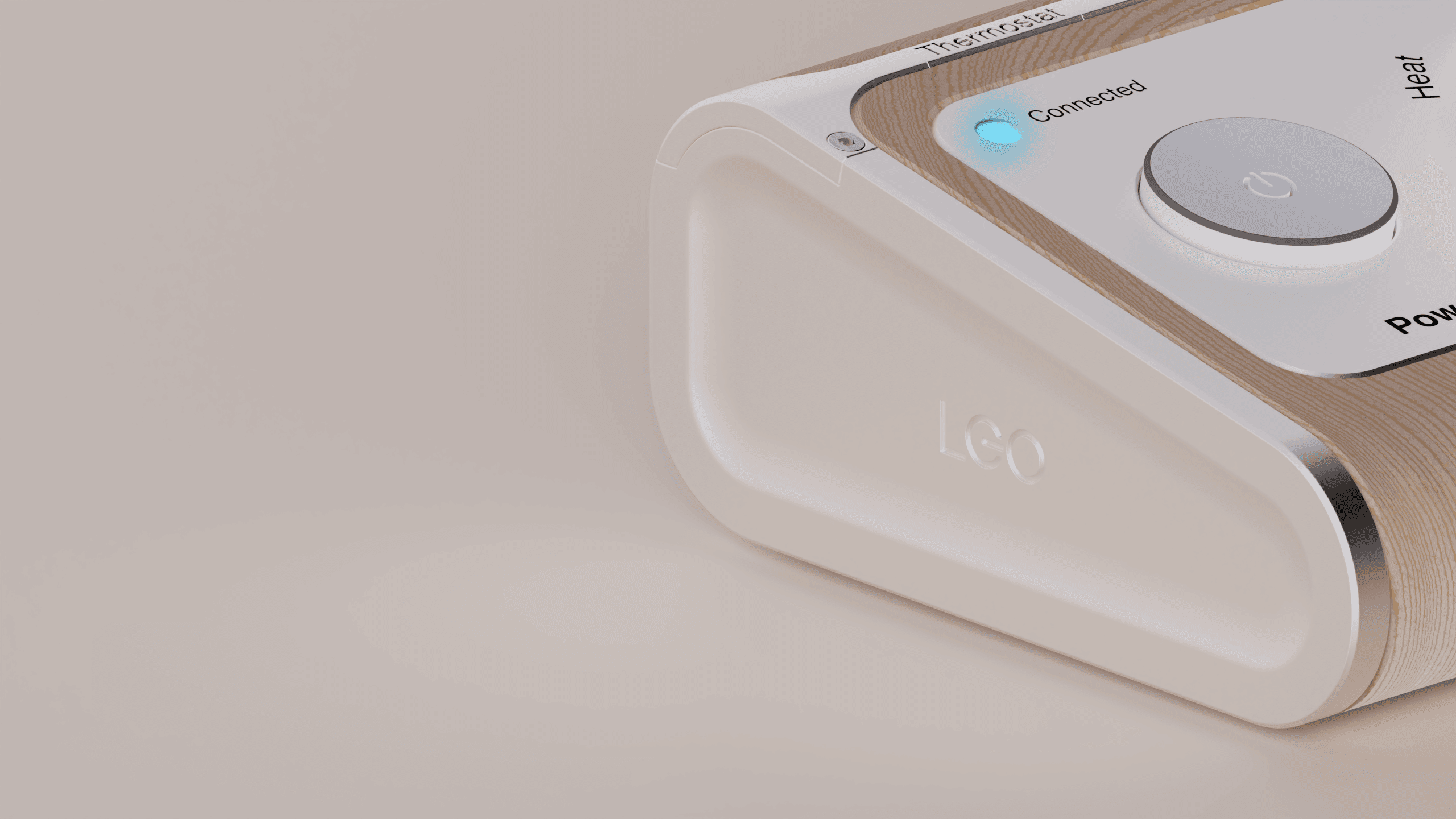

LEO close up render
Learnings and Design Philosophy
LEO taught me that designing for specific user groups isn't about simplification or patronisation; it's about respecting different mental models and interaction preferences. Older adults don't need "easier" technology; they need technology designed around their actual contexts, capabilities, and values. This insight extends beyond age to any user group: effective design requires understanding specific needs, not projecting universal assumptions.
The project reinforced that successful product design integrates industrial design, interaction design, and service design. LEO's physical form, interface behaviour, and setup service model are inseparable; each component depends on and reinforces the others. Treating these as separate disciplines would have produced a fragmented solution instead of a cohesive system.
I learned to value physicality in an increasingly digital world. There's a tendency in technology design to assume digital interfaces are inherently superior to physical controls. LEO demonstrates that physical interaction offers unique benefits: spatial memory, tactile confirmation, immediate legibility, and direct manipulation. The best interface isn't always the most technologically advanced; it's the one that best matches user needs and contexts.
The modular system approach taught me to design for growth and adaptation. Rather than creating a complete solution users must adopt wholesale, LEO allows incremental adoption that reduces risk and builds confidence progressively. This strategy respects that behaviour change takes time, and trust must be earned through demonstrated value.
Finally, the project validated that accessible design creates a better design for everyone. LEO's emphasis on clarity, physicality, and direct feedback benefits users of all ages and abilities. Designing for older adults with specific needs produced a system that's more intuitive and satisfying for everyone. This inclusive design principle now guides all my work: designing for those with the greatest needs elevates the experience for all users.